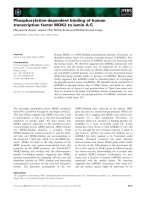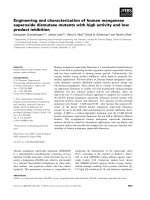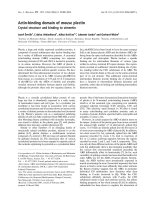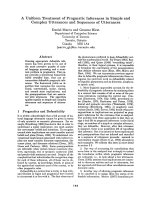báo cáo khoa học: " Multi-modality curative treatment of salivary gland cancer liver metastases with drug-eluting bead " pot
Bạn đang xem bản rút gọn của tài liệu. Xem và tải ngay bản đầy đủ của tài liệu tại đây (1.89 MB, 6 trang )
CAS E REP O R T Open Access
Multi-modality curative treatment of salivary
gland cancer liver metastases with drug-eluting
bead chemoembolization, radiofrequency
ablation, and surgical resection: a case report
Andreas Karatzas
1*
, Konstantinos Katsanos
2
, Ioannis Maroulis
3
, Christina Kalogeropoulou
1
,
Evaggelos Tzorakoleftherakis
3
and Dimitris Karnabatidis
2
Abstract
Introduction: Liver metastases are rare in salivary gland tumors and have been reported only once to be the first
manifestation of the disease. They are usually treated with surgical resection of the primary tumor and systemic
chemotherapy. Drug-eluting bead chemoembolization has an evolving role in the treatment of hepatocellular
carcinoma, as well as in the treatment of metastatic disease of the liver. Nevertheless, it has never been used in a
patient with salivary gland liver metastases.
Case presentation: We report a case of a 51-year-old Caucasian Greek woman who presented to our hospital
with liver metastases as the first manifestation of an adenoid cystic carcinoma of the left submandibular gland. The
liver lesions were deemed inoperable because of their size and multi-focality and proved resistant to systemic
chemotherapy. She was curatively treated with a combination of doxorubicin eluting bead (DC Beads)
chemoembolization, intra-operative and percutaneous radiofrequency ablation, and radiofrequency-assisted surgical
resection. The patient remained disease-free one year after the surgical resection.
Conclusion: In conclusion, this complex case is an example of inoperable liver metastatic disease from the salivary
glands that was refractory to systemic chemotherapy but was curatively treated with a combination of locoregio nal
therapies and surgery. A mul ti-disciplinary approach and the adoption of modern radiologi cal techniques produced
good results after conventional therapies failed and there were no other available treatment modalities.
Introduction
Salivary gland tumors are rare, histologically diverse, and
exhibit a variety of biological behaviors. They account
for 11% of all oropharyngeal neoplasms, with an inci-
dence of 11.95/1,000,000/year in the United States [1].
The frequency of distal metastases varies according to
the histological type [2,3]. Liver metastases are overall
quite rare and occur in advanced cases. It is extremely
rare for liver metastases to be the initial presentation,
and, to the best of our knowledge, only one case has
been reported in the literature [4].
Treatment of primary and secondary liver tumors has
changed during the past few years. New techniques,
both invasive and minimally invasive surgery, have
emerged and offer potential cure to patients who in the
past would have been considered candidates only for
palliative treatment. These treatments include drug-elut-
ing bead (DEB) chemoembolization, percutaneous and
intra-operative ablation, and atypical surgical resection
techniques. There is no report in the literature on the
use of DEB chemoembolizat ion for this type of meta-
static tumor.
We report a rare case of a patient with salivary gland
cancer who presented to our hospital with initially inop-
erable advanced metastatic liver disease as the first man-
ifestation of the disease. The patient was first treated
* Correspondence:
1
Department of Radiology, University Hospital of Patras, Rion, Patras 26504,
Greece
Full list of author information is available at the end of the article
Karatzas et al. Journal of Medical Case Reports 2011, 5:416
/>JOURNAL OF MEDICAL
CASE REPORTS
© 2011 Karatzas et al; licensee BioMed Central Ltd. This is an Open Access article distributed under the te rms of the Creative Commons
Attribution License (htt p://creativecommons.org/licenses /by/2.0), which permits unrestricted use, distribution, and reproduction in
any medium, provided the original work is properly cited.
successfully with a combination of locoregional treat-
ments and then underwent curative surgical resection.
Case presentation
A 51-year-old Caucasian Greek woman had a r outine
liver ultrasound examination following a history of
large-bowel polypectomies. Multiple hypoechoic liver
lesions were found, the largest of which, on segment VI,
measured 2.2 cm. The patient was asymptomatic, and
her physical examination was unremarkable. Routine
laboratory examinations showed no abnormal findings.
Apart from h er history of large-bowel polypectomies,
sheonlyhadahistoryofappendectomy35yearsago
and bilateral saphenectomy 23 y ears ago. To avoid
exposing the patient to ionizing radiation, the referring
physician decided to further evaluate t he lesions with
MRI of the abdomen, which demonstrated a total of
eight liver lesions in both lobes. The lesions had
reduced signaling on T1-weighted sequences and
increased signaling on T2-weighted sequences. They did
not show enhancement in the arterial phase and had
reduced enhancement compared to the normal liver
parenchyma in the portal venous phase. On the basis of
these features, metastatic liver disease was considered as
the first-line diagnosis. MRI did not show any other
abnormal findings.
To reveal the primary lesion, the patient was further
investigated with gastroscopy, colonoscopy, and com-
puted tomography (CT) of the head, lung, and abdomen,
all of which were unremarkable. Fine-needle aspiration
under CT guidance was performed on the lesion in seg-
ment VI. The cytology was positive for malignancy, the
type of which, though, could not be defined. Diagnostic
laparoscopy was then performed, and the anterior super-
ficial lesion in segment II was resec ted. The biopsy spe-
cimen submitted fo r pathological examinatio n showed
metastatic cancer with features of primary disease from
a cystic adenoid carcinoma of the salivary gland. Neck
CT was performed, which revealed a 1.5 cm hypodense
area on the left submandibular gland (Figure 1), thus
confirming the diagnosis.
The left submandibul ar gla nd was removed with clear
surgical margins, and the patient w as started on che-
motherapy treatment with cisplatin, doxorubicin, and
epirubicin. Three months later a new liver MRI scan
showed disease progression, and the chemotherapy was
switched to a combination of 5-fluorouracil (5-FU), cis-
platin, and cyclophosphamide. After 3 more months,
MRI demonstrated further enlargement of the liver
lesions, with the diameter of the biggest of them mea-
suring 10 cm (Figure 1).
At that time, chemo embolization with DC beads
loaded with doxorubicin was considered the best thera-
peutic option. Two sessions were performed two
months apart, and 150 mg of doxorubicin, loaded into
DC beads 300 mm to 500 mm and 500 mm to 700 mm
in diameter were injected each time. Because of the size
of the lesions and their bilateral location, the chemoem-
bolization was performed from the distal part of the
right and left hepatic arteries. The patient had post-
embolization syndrome, mainly with pain at the right
upper quadrant, which was worse after the second
embolization and was relieved only with opioid analge-
sics. No major compli cations were noted. Partial necro-
sis of the two larger lesions and complete obliteration of
the three smaller ones were noted on CT scans one
month after the first chemoembolization, and a further
response was demonstrated on CT scans one month
after the second chemoembolization (Figure 2).
Taking into consideration the partial response accord-
ing to the European Association for the Study of the
Liver criteria [5] and the left liver lobe hypertrophy in
the interim, surgical resection of the right liver and seg-
ment IV
A
was discussed and CT volumetry was per-
formed (Figure 3). The estimated functional liver
remnant was calculated as 41.8%, and the decision to
perform surgery was made.
An at ypical extended right hepatectomy was per-
formed, and the right liver lobe, along with segment IV
A
of the liver, was resected using a RF- assisted technique
to minimize bleeding complications (Figure 4). Intra-
operative ultrasound revealed one more lesion on
Figure 1 Pre-therapy imaging. (a) The primary tumor. Adenoid
cystic carcinoma of the left submandibular salivary gland is
indicated by the circle. (b) and (c) Computed tomography (CT) of
the liver before chemoembolization showing the two main lesions.
(b) A 10 cm lesion involving segments VI and VII is indicated by the
arrow. (c) A 4.7 cm lesion involving segments VIII and IV
A
is
indicated by the arrow. Three more lesions in segments IV
A
,IV
B
, and
II, which measured 1.5 cm, 1 cm, and 1.8 cm, respectively, were
identified.
Karatzas et al. Journal of Medical Case Reports 2011, 5:416
/>Page 2 of 6
segment II measuring 0.9 cm, which was treated with
intra-operative RF ablation. The surgical margins of the
removed liver were found to bedisease-freeaccording
to the pathology report.
The post-operative recovery of the patient was
uneventful apart from a small right pleural effusion,
which did not require furt her treatment. There was no
liver dysfunction a side from transient elevation of total
bilirubin up to 7.8 mg/dL (direct bili rubin 4.7 mg/dL).
The patient was discharged 15 days after surgery in
good general condition.
Follow-up CT three months after surgery showed a
new lesion measuring less than 1 cm on segment III.
This was treated with a single session of percutaneous
RF ablation. Eight months after surgery CT of the neck,
chest, abdomen, and pelvis showed that the patient was
Figure 2 CT of the liver after chemoembolization. Two partially necrotic lesions remained. The first, 8.9 cm in diameter, extended into
segments VI and VII, and the second, 4.2 cm in diameter, extended into segments VIII and IV
A
. (a) Arrow indicates the necrosis within the lesion.
The circle indicates necrosis of the normal liver parenchyma adjacent to the lesion in segment VIII. (b) The viable tumor at the periphery of the
lesion is shown.
Figure 3 CT volumetry of the liver. (d) through (f) The volume of segments II, III, and IV
B
, which were going to be spared during surgery,
were calculated and (a) through (c) divided by the volume of the functional liver before surgery. (a) and (b) The lesions were excluded for the
calculation of the functional liver volume.
Karatzas et al. Journal of Medical Case Reports 2011, 5:416
/>Page 3 of 6
free of disease. At the one-year post-operative follow-up
examination, a positron emission tomography (PET)
scan (Figure 5) and MRI of the abdomen showed that
the patient remained free of any metastatic disease.
Discussion
Liver metastasis from salivary gland cancer is an uncom-
mon manifestation of the disease, so evidence is scarce
concerning the appropriate treatment. Adenoid cystic
carcinoma, contrary to most other salivary gland
tumors, is an aggressive tumor with a relatively high
ratio of distant metastases. Patients with distant metas-
tases have been shown to have a three-year survival rate
of 41% to 46% [6,7]. Surgical resection of the primary
tumor and systemic chemotherapy are recommended
[8,9], although surgical resection of solitary metastases
has been reported [10]. The chemotherapeutic agents
that have shown the best results as monotherapy are cis-
platin, 5-FU, and doxorubicin. The combination o f
cyclophosphamide plus doxorubicin and cisplatin has
proven to be the most effective chemotherapy treatment
[7].
Chemoembolization has been widely used for liver
metastatic disease, mainly for colorectal and neuroendo-
crine tumo r metastases [11]. Drug-eluting microspheres
have been introduced recently and have been used for
the treatment of hepatocellular carcinoma and meta-
static disease. It has been shown that they have more
favorable pharmacokinetics than conventional che-
moembolization, since they provide higher concentra-
tions of the chemotherapeutic agent in the area of the
tumor and less in the systemic circulation. Additionally,
the chemotherapeutic agent remains in the area of the
tumor for a longer period [12,13]. This case shows the
potential of chemoembolization with DC Beads fo r the
treatment of v arious metastatic tumors, even those with
relatively low vascularity.
Bearing in mind the chemotherapeutic agents to
which the patient showed no response when treated sys-
temically, as well as the regimens proposed in the litera-
ture for metastatic salivary gland tumors, we decided
that doxorubicin was the best choice. The ability to load
it into DC Be ads was another advantage that could not
be overlooked. Because of the size of the lesion, the che-
moembolization could not be selective. Given also the
fact that the liver of the patient was not cirrhotic, both
lobes were treated each time.
The good response of the patient to the first two che-
moembolizations posed a th erapeutic dilemma about
the next step. Our goal was to offer surgery to the
patient as a potentially curative treatment. The minor
down-sizing of the lesions, along with the left lobe
hypertrophy, allowed us to proceed with surgery. Resec-
tion of the tumor with a remaining functional liver
volume greater than 20% is considered to be safe for a
non-cirrhotic liver. In our patient, the estimated relative
liver remnant was calculated to be 41.8%. This would
also allow the safe intra-operative ablation of any
remaining foci in the left lobe. Portal vein embolization
was also considered before starting the chemoemboliza-
tion as an alterna tive treatment that could produce left
lobe hypertrophy and potentially offer the opportunity
to perform surgery. However, this option was rejected
because of the rapid progression of the lesions.
During surgery, intra-operative ultrasound revealed
one more lesion that was not visible on CT scans. It has
been shown that intra-operative ultrasound is a very
sensitive modality f or the detection of small metastases
in the liver [14] and is considered a mandatory part o f
the procedure [15]. Nevertheless, there wa s still concern
that additional microscopic foci could exist. This war-
ranted prompt follow-up, which indeed was successful
in revealing an early recurrence small enough to be trea-
ted with percutaneous RF ablation. The modality and
Figure 4 Specimen of the resected liver. The tumors in segments VI and VII (arrowheads) and segments VIII and IV
A
(arrows) are shown.
Karatzas et al. Journal of Medical Case Reports 2011, 5:416
/>Page 4 of 6
frequency of follow-up for such a metastatic tumor is
not well established. We used CT at three months and
then at eight months because CT of the liver was also
performed during t he percutaneous RF ablation. At the
patient’s one-year follow-up examination, we used MRI
of the abdomen and PET in an effort to reduce the
radiation dose, bearing in mind, though, that since there
was no previous PET scan, the tumor could be PET-
negative and render a false-negative result. In this way,
we managed to reduce the effective dose from 25mSv
(CT of the neck, chest, abdomen, and pelvis) to approxi-
mately 14mSv (PET scan with low-dose CT).
Surgeryisdefinitelynotthetreatmentofchoicefor
patients with metastatic liver disease from an adenoid
cystic carcinoma, since even without treatment survival
can be prolonged and there is no solid evidence that
resection of the metastases prolongs survival. However,
the biologic behavior of the tumor of this particular
patient, bearing in mind the rapid increase in the size of
the lesions, was quite aggressive. Furthermore, the age
of the patient rendered her a good candidate for surgery,
and she urged us to offer a more aggressive therapeutic
approach to offe r her a chance of living disease-free and
possibly prolonging her survival. Nevertheless, further
Figure 5 Positron emission tomography scan at one-year follow-up. The PET scan was negative for any recurrent disease.
Karatzas et al. Journal of Medical Case Reports 2011, 5:416
/>Page 5 of 6
follow-up is needed, since late recurrence occurs quite
often in patients with adenoid cystic carcinoma, but
since the tumor burden in our patient was reduced, any
recurrence would be more easily treatable with RF
ablation.
Conclusion
It is im portant to hig hligh t the synergistic role of mod-
ern diagnostic and interventional techniques to the out-
come of this case. Chemoembolization with DC Beads
hindered the progression of the disease and achieved a
partial response. Thin-section CT volumetry contributed
to the decision to perform surgery by accurately calcu-
lating the functional liver remnant. Intra-operative ultra-
sound revealed a lesion that had not been pinpointed by
conventiona l imaging techniques and also provided real-
time guidance for the intra-operative ablation. Finally,
percutaneous RF ablation permitted treatment of the
disease recurrence with minimal invasion.
In conclusion, this case is a rare manifestation of ad e-
noid cystic carcinoma of the salivary glands. Addition-
ally, it is an example of inoperable liver metastatic
disease refractory to sy stemic chemotherapy which was
curatively treated with a combination of locoregional
therapies and surgery. A multi-disciplinary approach
and the adoption of modern radiological techniques pro-
duced good results after conventional therapies had
failed and there were no other available therapeutic
modalities.
Consent
Written informed consent was obtained from the patient
for publication of this case report and any accompany-
ing images. A copy of the written consent is available
for review by the Editor-in-Chief of this journal.
Author details
1
Department of Radiology, University Hospital of Patras, Rion, Patras 26504,
Greece.
2
Department of Interventional Radiology, University Hospital of
Patras, Rion, Patras 26504, Greece.
3
Department of Surgery, University
Hospital of Patras, Rion, Patras 26504, Greece.
Authors’ contributions
AK participated in the interventional radiology procedures and the review of
the imaging examinations and was a major contributor in the writing of the
manuscript. KK participated in the interventional radiology procedures,
performed the intra-operative ultrasound, and was a major contributor in
the revision of the manuscript. IM performed the surgery and contributed to
the surgical aspects of the manuscript. CK reviewed the imaging
examinations and revised the manuscript. ET performed the surgery and
revised the manuscript. DK participated in the interventional radiology
procedures and made the final changes to the manuscript. All authors
participated in the decision making of this case. All authors read and
approved the final manuscript.
Competing interests
The authors declare that they have no competing interests.
Received: 6 February 2011 Accepted: 25 August 2011
Published: 25 August 2011
References
1. Boukheris H, Curtis RE, Land CE, Dores GM: Incidence of carcinoma of the
major salivary glands according to the WHO classification, 1992 to 2006:
a population-based study in the United States. Cancer Epidemiol
Biomarkers Prev 2009, 18:2899-2906.
2. Bradley PJ: Distant metastases from salivary glands cancer. ORL J
Otorhinolaryngol Relat Spec 2001, 63:233-242.
3. Schwentner I, Obrist P, Thumfart W, Sprinzl G: Distant metastasis of
parotid gland tumors. Acta Otolaryngol 2006, 126:340-345.
4. Deshpande AH, Kelkar AA: Hepatic metastasis as an initial manifestation
of salivary adenoid cystic carcinoma: cytologic diagnosis. Diagn
Cytopathol 2009, 37:45-47.
5. Bruix J, Sherman M, Llovet JM, Beaugrand M, Lencioni R, Burroughs AK,
Christensen E, Pagliaro L, Colombo M, Rodés J, EASL Panel of Experts on
HCC: Clinical management of hepatocellular carcinoma: conclusions of
the Barcelona-2000 EASL conference. European Association for the
Study of the Liver. J Hepatol 2001, 35:421-430.
6. Kim KH, Sung MW, Chung PS, Rhee CS, Park CI, Kim WH: Adenoid cystic
carcinoma of the head and neck. Arch Otolaryngol Head Neck Surg 1994,
120:721-726.
7. Spiro RH: Distant metastasis in adenoid cystic carcinoma of salivary
origin. Am J Surg 1997, 174:495-498.
8. Bell RB, Dierks EJ, Homer L, Potter BE: Management and outcome of
patients with malignant salivary gland tumors. J Oral Maxillofac Surg
2005, 63:917-928.
9. Guzzo M, Locati LD, Prott FJ, Gatta G, McGurk M, Licitra L: Major and minor
salivary gland tumors. Crit Rev Oncol Hematol 2010, 74:134-148.
10. Qureshi SS, Nadkarni MS, Shrikhande SV, Desai S, Deodhar K, Ramadwar M,
Shukla PJ: Hepatic resection for metastasis from adenoid cystic
carcinoma of parotid gland. Indian J Gastroenterol 2005, 24:29-30.
11. Liapi E, Geschwind JF: Chemoembolization for primary and metastatic
liver cancer. Cancer J 2010, 16:156-162.
12. Varela M, Real MI, Burrel M, Forner A, Sala M, Brunet M, Ayuso C, Castells L,
Montañá X, Llovet JM, Bruix J: Chemoembolization of hepatocellular
carcinoma with drug eluting beads: efficacy and doxorubicin
pharmacokinetics. J Hepatol 2007, 46:474-481.
13. Hong K, Khwaja A, Liapi E, Torbenson MS, Georgiades CS, Geschwind JF:
New intra-arterial drug delivery system for the treatment of liver cancer:
preclinical assessment in a rabbit model of liver cancer. Clin Cancer Res
2006, 12:2563-2567.
14. Nomura K, Kadoya M, Ueda K, Fujinaga Y, Miwa S, Miyagawa S: Detection
of hepatic metastases from colorectal carcinoma: comparison of
histopathologic features of anatomically resected liver with results of
preoperative imaging. J Clin Gastroenterol 2007,
41:789-795.
15. Ellsmere J, Kane R, Grinbaum R, Edwards M, Schneider B, Jones D:
Intraoperative ultrasonography during planned liver resections: why are
we still performing it? Surg Endosc 2007, 21:1280-1283.
doi:10.1186/1752-1947-5-416
Cite this article as: Karatzas et al.: Multi-modality curative treatment of
salivary gland cancer liver metastases with drug-eluting bead
chemoembolization, radiofrequency ablation, and surgical resection: a
case report. Journal of Medical Case Reports 2011 5:416.
Karatzas et al. Journal of Medical Case Reports 2011, 5:416
/>Page 6 of 6









